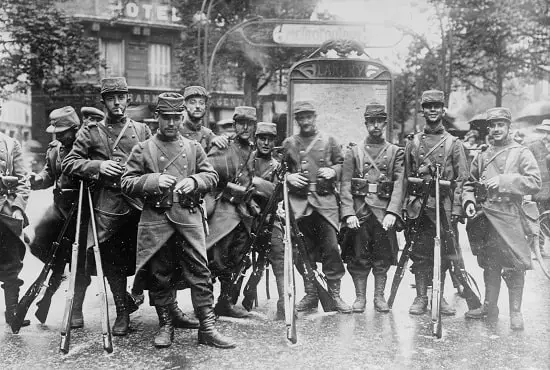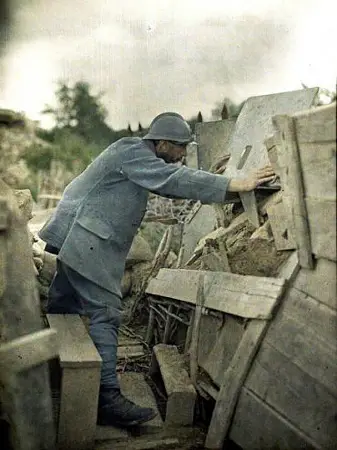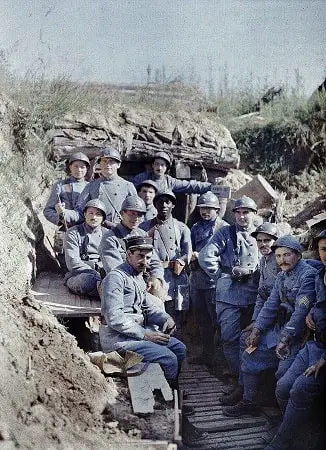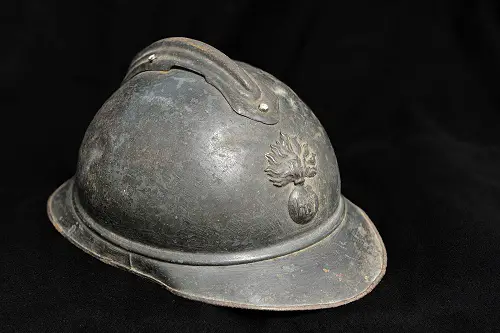France was part of the Triple Entente states that joined against the Central Powers during World War 1.
Although fighting happened worldwide, most of the conflict in Europe occurred in Belgium, Luxembourg, France, and Alsace-Lorraine.
Similarly, most ground warfare happened along what became known as the Western Front, which consisted primarily of trench warfare.
Particular functional, tactical, and strategic decisions made by high command on both sides of the battle resulted in organizational capacity shifts.
The French Army also attempted to respond to day-to-day fighting and long-term operational and strategic agendas.
Many challenges, in particular, compelled the French high command to re-evaluate normal processes. They also remodeled command structures, re-equip the military, and devised new tactical techniques.
The Bright Blue French Army Uniform Features of WW1
Content

French Army used brightly colored conventional garments as their active wardress that were used during the 19th century during the outbreak of World War 2.
This included noticeable elements such as blue jackets and crimson trousers for all the cavalries and infantries. And the cuirassiers wore breastplates and plumed helmets that had been used since the Napoleonic era.
However, the dress was attempted to be made more practical for the battlefield but failed for having to go through traditionalist opposition within the general public and troops.
The infantry’s crimson trousers, in particular, were a political talking topic.
Adolphe Messimy, Minister of War ( 1911 to 1912 ), claimed the dumb naive adherence to the most noticeable colors would have painful repercussions.”
On the other hand, Eugène Étienne ( Adolphe’s successor ) reacted by stating never to abolish the red trousers.
A new cloth, known as the “Tricolor cloth,” was created to appease social conservatives. It was weaved using white, blue, and red threads, culminating in a dull purple-brown color.
Sadly, the thread with red color could only be made using a German dye. Hence only the two blue and white stitches were used in the uniform.
The French Chamber of Deputies approved the blue-grey uniform on July 10, 1914.
But new issues could not be introduced before the onset of war a few weeks later. And their dress was made specially in blue-grey color to prevent the force from being the highlight against the skyline. This dress was also termed a Horizon blue colored dress.
The Horizon Blue Color

Horizon blue is a well-known color designation since it was used for the blue-grey uniforms of French metropolitan troops from 1915 to 1921.
This name for a shade of blue alludes to the intangible color that divides the sky from the earth. It had also functioned as an icon of political factions triumphing against the Great War’s Army.
The color of the French army uniform became known as “horizon blue” in three stages. The first orders, issued in 1914, specified a new uniform fabric as “light blue.”
Then, on January 16, 1915, an article in L’Illustration dubbed the color of the soldiers’ uniforms as “horizon color.” Le Matin compared this color to horizon blue on the 26th.
The old and new uniforms were compared in February by the daily Le Temps: “The dark material of the old overcoats is seen side by side with the pale blue of the new “horizon color” outfit.”
Consequently, the term gained currency in the spring of 1915. In September, it had become horizon blue insensibly and was widely used. It would never be accepted as an official term.
On August 2, 1914, the day of general deployment, the Ministry of War adopted a one-of-a-kind blue material to produce uniform sets.
On the recommendation of Mr. Balsan, a fabric maker in Châteauroux, the Logistics Chief Defait, director of logistics for the Ministry of War, renounces using tricolor cloth on August 8.
Two factors hampered the adoption of tricolor cloth. One was a lack of alizarin, a synthetic madder dye produced in Germany, among other places, by BASF.
The other was the difficulty of putting tricolor cloth into manufacturing by French cloth manufacturers, for whom uniform manufacturing was hard to arrange amid the war.
Maurice Allain, the mill’s director of production, recommends, in particular, a cloth that returns to the procedure of dyeing wool fibers of the fabric “blued steel grey” meant for prewar overcoats.
The fabric producers would not squander the wool fibers that had already been dyed for that reason, and the dyers’ know-how would be preserved.
On August 16, 1914, Roger de La Selle, the administrative supervisor of drapery at Châteauroux, delivered samples to Paris for the war ministry.
During the day, Logistics Chief Defait delivered the cloth samples to Adolphe Messimy’s office, where he chose the blued steel grey cloth accented with light blue and white fibers.
The next day, August 17, 1914, this fabric is formally adopted for pieces of uniforms for the French Army.
Repercussions of the French Uniform at the time of the Battle of the Frontiers

The Battle of the Frontiers culminated in conflicts waged along France’s eastern border and southern Belgium soon after World War 1.
The battles remedied the military tactics of French Chief of Staff General Joseph Joffre with Plan XVII and an aggressive explanation of the German Aufmarsch II.
The strategy for the battle was the implementation strategy by Helmuth von Moltke the Younger.
Plans included the German accumulation on the right (northern) flank to pedal through Belgium and strike the French in the rear.
The German advance was slowed by the French Fifth Army (General Charles Lanrezac) moving to the northwest to intercept them.
It also led to the British Expeditionary Force (BEF) deployment on the French left flank.
The Germans conquered northern France after driving out the Franco-British soldiers. The French and British counterattack efforts slowed the German advance.
The counterattack allowed the French to move forces from the eastern boundary to the western frontier to safeguard Paris. Consequently, it led to the First Battle of the Marne.
The increased visibility of their wat uniforms and peacetime tactics that emphasized mass unit attacks contributed to the exceptionally significant French casualties at the Battle of the Frontiers.
The limitation of the French uniform was rapidly recognized, and systematic dissemination of horizon-blue garments with simplified patterns had begun by 1915.
The military tradition of wearing a back-buttoned dress on the march and greatcoats on the battlefield continued in the channel. However, the leather gaiters were replaced by the puttees styled by the British in October of 1914.
The Adrian Helmet

The French Army primarily used steel helmets for shrapnel defense which by December of 1915 had a production of ‘Adrian’ helmets that ranged over 3 million.
The combination of these Adrian helmets and the horizon-blue uniform was so functional that they were kept unmodified for the rest of the battle.
However, around December 1914, the Khaki in the shade of mustard was adopted specially for the North American troops of the 19th Military District that were placed in France.
The helmet’s original form, the M15, was the French Army’s first standard helmet, built when millions of French men were engaged in trench combat.
Head wounds from falling shrapnel created by indirect fire were a common cause of battlefield losses.
It was the first modern steel helmet introduced in 1915 and remained the standard helmet of many armies far into the 1930s.
Issued initially to infantry personnel, they were later modernized and issued to cavalry and tank crews. A later version, the M26, was also utilized during World War 2.
When World War 1 took place in August 1914, soldiers in the French Army wore the conventional kepi cap, which offered no protection against damage.
Early trench warfare demonstrated that even simple head protection resulted in a much lower fatality rate among frontline men.
By the beginning of 1915, a simple steel skull cap was being provided to be worn beneath the kepi.
As a result, the French staff directed the construction of a metal helmet capable of protecting troops from the debris of explosive artillery shells.
Because soldiers in trenches were susceptible to shrapnel blasting over their heads, a deflector crest was placed along the axis of the helmet.
Front branch insignia included a grenade for line troops and cavalry and a bugle horn for chasseurs. A crossed cannon was placed for artillery, an anchor for colonial forces, and a crescent for North African units.
The Army’s helmet was composed of mild steel and weighed only 0.765 kg (1 lb 11.0 oz). It was lighter and less protective than the modern British Brodie helmet and German Stahlhelm.
The helmets were ordered in the spring of 1915 and issued by July. By September, all frontline troops in France had received the helmet.
Conclusion
The uniform chronology provides a unique perspective on creating the state and national emotion in Europe and the continent’s economic and social transformations.
On the other hand, military outfits are inextricably linked to a specific war experience, connecting to conscripted armies and propagating the war experience to the populace.
Thus, the evolution of the uniform occurs at the crossroads of technical issues related to the rising deadliness of weapons and anthropological considerations related to the interpretations connected with this outfit in diverse European nations.
